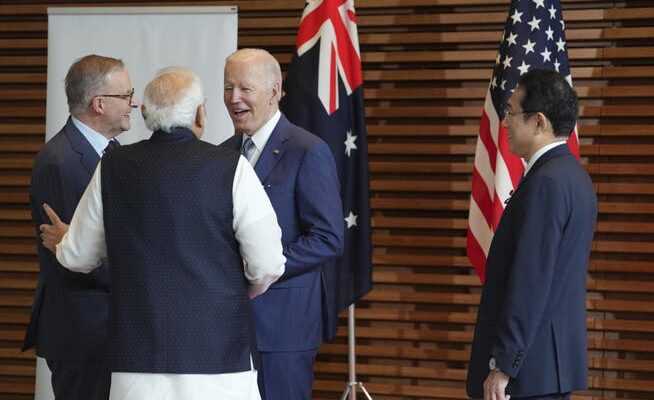Together with Australia, India and Japan, the USA has formed the loose state federation Quad. The four countries launched a joint initiative on Tuesday. It is part of Biden’s strategy to counter China’s influence in Asia – and expand America’s influence.
The heads of government of the four democracies of the Quadrilateral Security Dialogue (Quad): Australia’s new Prime Minister Anthony Albanese, Indian Prime Minister Narendra Modi, American President Joe Biden and Japan’s Prime Minister Fumio Kishida (from left to right).
On Tuesday, US President Joe Biden agreed in Tokyo with the heads of government of Japan, India and Australia on an initiative to improve maritime surveillance in the Indo-Pacific. The so-called quad alliance thus criticizes China in a barely disguised manner. Those in power in Beijing are accused of at least tolerating illegal fishing in territorial waters.
Through targeted cooperation, the Quad wants to monitor the seas of Asia in real time in order to ensure “a free and open Indo-Pacific,” according to the White House. The data is to be made available to interested countries in Southeast Asia so that they can track ships that have switched off their tracking systems required by maritime law.
The offer highlights the new US strategy to counter China’s growing influence in Asia through multilateral alliances – with America at the centre. In doing so, the American government is deviating from its post-war strategy of establishing inclusive international organizations such as the United Nations or the World Bank, where it now has to share more power with rival China. “The United States prefers solidarity tailored to each case,” says Lee Shin Wha, a foreign policy expert at Korea University in Seoul.
Biden’s Asia strategy: the main thing is against China
In Washington, this strategy is also called “plurilateralism”. The American government wants to establish a new model of cooperation that is directed against China. The alliances under this strategy are piling up, making it difficult to keep track of them. In autumn 2021 he initiated the T12. The T stands for technology: The USA wants to promote and protect technologies that are considered important in competition with China, together with other technologically powerful democracies. In March he proposed in his “chip alliance” a semiconductor cooperation between the Asian chip strongholds Japan, South Korea and Taiwan with America.
The preliminary highlight on Monday was the economic framework agreement for the Indo-Pacific IPEF (Indo-Pacific Economic Framework). Twelve states from the region are participating. It’s about securing important supply chains, digital economy, investments in renewable energies, fighting corruption. Two points are particularly important for the USA: It is not a free trade agreement, which is frowned upon at home. And China is excluded.
The Quad is also a more recent addition. There were already first ministerial meetings under Biden’s predecessor Donald Trump. The body is not intended to be a military alliance, but a forum in which the four countries coordinate important issues in order to gain more influence in the region together.
However, James Brady, East Asia expert at security advisor Teneo Intelligence, sees a problem: “The Quad is a framework that is still looking for its purpose.” A White House official, on the other hand, says the Quad has already become “a permanent fixture in the regional order.” In their joint statement, the four participants even describe themselves as “a force for good” who want to bring “tangible benefits” to the region. In the second year, they want to help make the region more resilient.
Quad meeting in Japan: dispute over Russia
In individual cases, however, the self-proclaimed value partners argue, for example in the Ukraine war. While Biden, Kishida and Albanese vehemently criticized Russia’s attack, India’s Prime Minister Modi remained silent on the issue. The country sources raw materials from Russia and intends to continue doing so.
In competition with China, India is less willing to fly the flag alongside the US. But Biden priced that in. For the military part, the US has its security alliances. The latest is Aukus, in which Australia, Great Britain and the USA have joined forces. On his trip to Asia, Biden also strengthened the alliances with his two most important partners, South Korea and Japan, also economically. Among other things, the three countries want to work together on the development of batteries, chips and other important components in order to become more independent of China.
Biden sides with Taiwan – or not?
At least the Quad sharpened its tone towards China in the final statement. Without naming China, she sharply opposed “any coercive measures, provocations or unilateral actions aimed at changing the status quo and increasing tensions in the area.” This is exactly what they accuse China of doing.
To do this, Biden provoked the strategic rival at its most sensitive point. For the third time, Biden reiterated that the US had an obligation to defend Taiwan if China invaded. In doing so, the American President once again shook up the “strategic ambiguity” that had long been the basis of American-Chinese relations: in 1979, the United States recognized the People’s Republic as China’s only legal government. At the same time, Washington undertook in the “Taiwan Relations Act” to supply Taipei with arms.
Biden himself said on Tuesday that nothing had changed in this position. A prankster on Twitter then summed up Biden’s approach as follows: “The Biden administration appears to be pursuing a policy of strategic ambiguity when it comes to whether or not its policy of strategic ambiguity regarding Taiwan has actually changed.”
